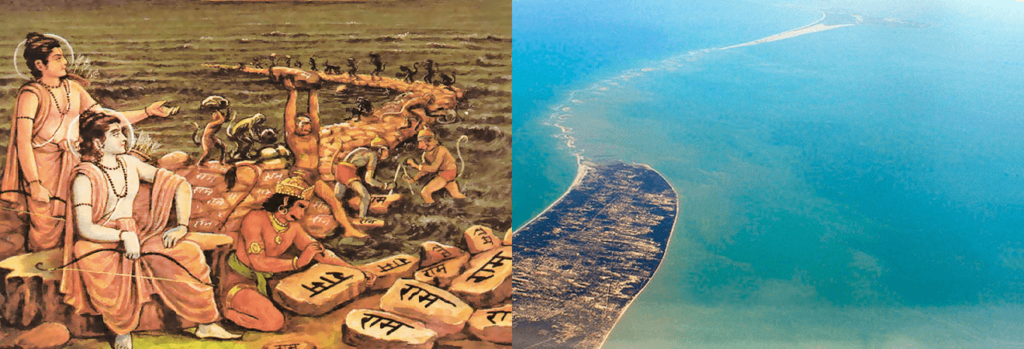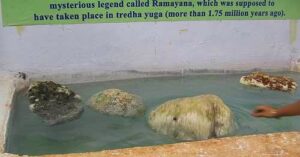Ram Setu Floating Stone Facts and Truth- Blogs Year

The “Ram Setu” or Adam’s Bridge is a chain of limestone shoals between the Indian mainland and Sri Lanka. According to Hindu mythology, it was built by Lord Rama and his army of monkeys to reach Lanka and rescue his wife Sita from the demon king Ravana. Scientifically, it is believed to have been formed as a result of sediment accumulation over a period of time. There is no evidence to support the existence of floating stones used to build the bridge.
The Ram Setu Floating Stone Mystery has persisted for many years in Rameshwaram.
Even after experts confirm that the mystery of the floating stones exists, people have failed to accept the solutions. Many fascinating findings that left us speechless were made as a result of conversations on the mystery surrounding the Ram Setu floating stone.

Where is Ram Setu Exactly Located?
Ram Setu, also known as Adam’s Bridge, is located between the Indian mainland and the Sri Lankan island. It is a chain of limestone shoals that runs between the Indian Peninsula of Rameswaram, Tamil Nadu and Mannar Island, Sri Lanka.
What is The Story Behind Floating Stone?
The floating stone is a popular story in Hindu mythology, associated with the building of Ram Setu, a bridge connecting India and Sri Lanka. According to the Hindu epic Ramayana, the god Rama, with the help of an army of monkeys, built the bridge to rescue his wife Sita, who had been abducted by the demon king Ravana and taken to Sri Lanka.
According to the story, the monkeys were unable to find rocks heavy enough to build the bridge, so the god Hanuman was sent to bring a piece of the Himalayas to serve as the foundation. Hanuman, however, was unable to carry the entire mountain, so he took a smaller piece which he held in his hand.
When he reached the ocean, Hanuman was challenged by the ocean god to show that he had brought the rock for a worthy cause. Hanuman threw the rock into the ocean, and it is said to have floated, allowing the monkeys to walk across it and lay the foundation for the bridge.
The story of the floating stone is considered a testament to the power of devotion and the victory of good over evil in Hindu mythology.
How does the floating Stone Appear At Adam’s Bridge?
The appearance of floating stones at Ram Setu, also known as Adam’s Bridge, is a natural phenomenon caused by the unique geology of the area. The bridge is a chain of limestone shoals that runs between the Indian coast of Rameswaram, Tamil Nadu and Mannar Island, Sri Lanka.
The stones that make up the shoals are composed of light-weight limestone and sandstone, which have low density and can float in water. This makes it possible for the stones to remain above the surface of the ocean, giving the appearance of a bridge floating on the water.
The stones have been shaped and formed over millions of years by the action of water, wind, and other geological processes. The floating stones at Ram Setu are a testament to the power of natural forces and the ongoing evolution of the earth.
Why was Ram Setu Called Adam’s Bridge?
Ram Setu, a chain of limestone shoals between India and Sri Lanka, is also known as Adam’s Bridge. The name is believed to have originated from the medieval period, when Arab traders and Muslim scholars visiting the region associated the bridge with the biblical figure Adam.
According to Islamic tradition, Adam was the first man created by God and lived in Sri Lanka. The bridge was seen as a connection between Sri Lanka and the mainland, where Adam is said to have lived after being expelled from the Garden of Eden.
The name “Adam’s Bridge” has been used for centuries to describe the bridge, and it has become an important site for both Hindu and Muslim pilgrims. The connection with the biblical figure Adam has helped to enhance the bridge’s cultural and historical significance, and it continues to be known by this name today.
Is Ram Setu Natural Or Manmade?
Ram Setu, also known as Adam’s Bridge, is a natural formation. It is a chain of limestone shoals that runs between the Indian coast of Rameswaram, Tamil Nadu and Mannar Island, Sri Lanka. The shoals are believed to have been formed over millions of years by the action of wind, water, and other geological processes.
There is no evidence to support the claim that the bridge was built by humans, and the scientific consensus is that Ram Setu is a natural formation. The bridge has been studied by geologists and oceanographers, who have concluded that it was created by the accumulation of sediment transported by ocean currents and waves.
However, the bridge has great cultural and religious significance in India, and there are legends and stories in Hindu mythology that associate the bridge with the god Rama and his quest to rescue his wife Sita from the demon king Ravana. Despite its natural origin, the bridge continues to hold a special place in the hearts and minds of many Indians.
Is Floating Stone a Part Of Volcano?
In scientific claims, it is believed that the Ram Setu is made of floating stone volcanoes.
Can We Walk on Ram Setu?
It is not possible to walk on Ram Setu, also known as Adam’s Bridge, as it is a chain of shoals that are partially submerged in the ocean and are constantly shifting and changing. The shoals are composed of light-weight limestone and sandstone, which can be unstable and prone to breaking or shifting, making it dangerous to walk on them.
Additionally, the shoals are located in an area that is subject to strong ocean currents, high waves, and unpredictable weather, making it difficult and dangerous for boats and ships to navigate, let alone for people to walk on.
Therefore, for safety reasons, it is not recommended to walk on Ram Setu. If you want to visit the area, it is best to take a boat tour or view it from a safe distance.
What is the real name of Ram Setu stone name?
The real name of Ram Setu, also known as Adam’s Bridge, is “Rama’s Bridge.” “Ram Setu” is a Sanskrit term that literally means “Rama’s Causeway.” The bridge is named after the Hindu god Rama, who is said to have built the bridge with the help of an army of monkeys to rescue his wife Sita from the demon king Ravana.
The name “Adam’s Bridge” is derived from Islamic and medieval tradition, which associates the bridge with the biblical figure Adam. According to Islamic tradition, Adam lived in Sri Lanka after being expelled from the Garden of Eden, and the bridge was seen as a connection between Sri Lanka and the mainland.
Why do ram setu stones float?
The motivation behind NASA and the scientific firm Float demonstrates how science works.
However, according to religious doctrine, due to Lord Varuna’s blessings and the name of Lord Rama, stones cannot float on water.
Ram Setu Facts And Information
Here are some facts and information about Ram Setu, also known as Adam’s Bridge:
Location: Ram Setu is a chain of shoals that runs between the Indian coast of Rameswaram, Tamil Nadu and Mannar Island, Sri Lanka.
Formation: Ram Setu is a natural formation created by the accumulation of sediment transported by ocean currents and waves. The shoals are composed of light-weight limestone and sandstone, which have low density and can float in water.
Cultural Significance: Ram Setu is considered an important site for both Hindu and Muslim pilgrims, and holds great cultural and historical significance in India. It is associated with the Hindu god Rama and his quest to rescue his wife Sita from the demon king Ravana.
Scientific Research: The shoals of Ram Setu have been studied by geologists and oceanographers, who have concluded that the bridge is a natural formation created by the accumulation of sediment over millions of years.
Accessibility: It is not possible to walk on Ram Setu, as it is a chain of shoals that are partially submerged in the ocean and are constantly shifting and changing. The shoals are located in an area that is subject to strong ocean
currents, high waves, and unpredictable weather, making it difficult and dangerous for boats and ships to navigate.
Conservation: The government of India has designated Ram Setu as a protected monument, and has taken steps to conserve the bridge and its surrounding ecosystem. The area is considered a biodiversity hotspot, and is home to a variety of plant and animal species.
Controversy: There have been debates and controversies over the years about the origin and status of Ram Setu, with some people claiming that it was built by humans, while others believe it to be a natural formation. The scientific consensus is that Ram Setu is a natural formation, created by geological processes over millions of years.
Ram Setu Floating Stone Scientific Validation
The floating stones at Ram Setu, also known as Adam’s Bridge, have been scientifically validated as a natural formation. The shoals have been studied by geologists and oceanographers, who have concluded that they are the result of sediment transported by ocean currents and deposited over millions of years.
The stones that make up the shoals are composed of light-weight limestone and sandstone, which have low density and can float in water. The low density of the rocks is due to the porous nature of the rocks and the presence of air pockets within them.
Additionally, the presence of corals, shells, and other marine fossils in the shoals supports the scientific conclusion that Ram Setu is a natural formation created over a long period of time.
The scientific consensus is that Ram Setu is a naturally occurring geological feature, and that it was not built by humans. However, there have been debates and controversies over the years about the origin and status of Ram Setu, with some people claiming that it was built by humans, while others believe it to be a natural formation.
Lava strikes water with a frigid shock because there is a significant temperature difference between the two.
It immediately freezes as a result. The stone appears spongy because to the bubbles that have been trapped inside of it, which causes it to float in water.
Rameshwaram’s coastal area is home to several of the Ram Setu Floating Stones. These floating rocks share the same characteristics, physical and chemical components, and properties as other rocks.







